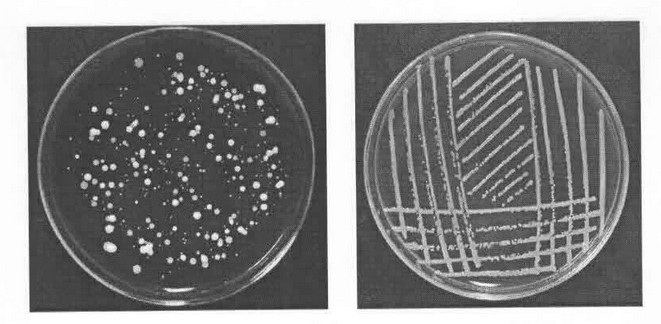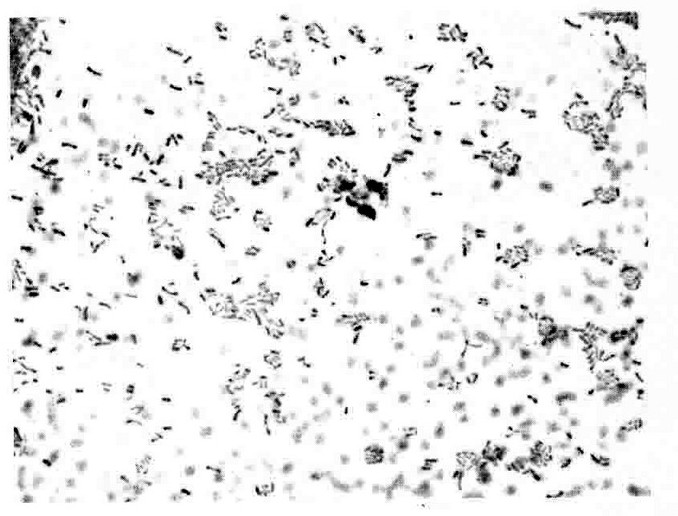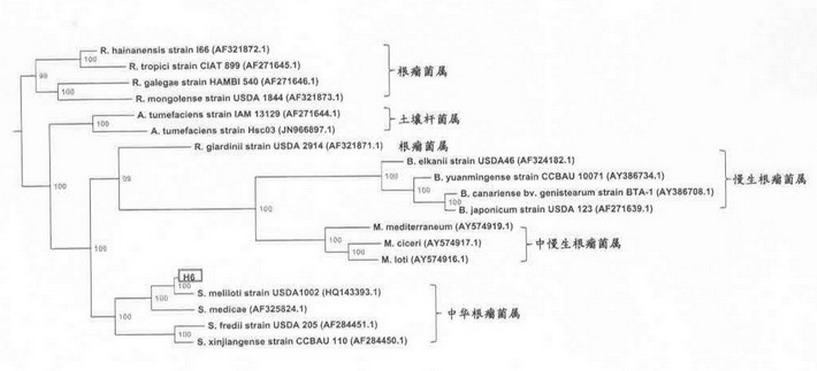Sinorhizobium nitrogen-fixing strain h6 and its application
A technology of Sinorhizobium and Sinorhizobium, applied in the direction of application, bacteria, and microorganisms, can solve the problems affecting the yield of alfalfa, achieve the effects of increasing the biomass of alfalfa, alleviating salt damage, and improving nitrogen nutrition
- Summary
- Abstract
- Description
- Claims
- Application Information
AI Technical Summary
Problems solved by technology
Method used
Image
Examples
Embodiment 1
[0043] Isolation and purification of Azotobacter sinensis strain H6:
[0044] Take fresh root nodules, rinse them with water, blot the surface moisture with filter paper, put them in ethanol with a volume concentration of 95% for 3 minutes, take them out, rinse them with sterile water for 5-6 times, and then put them in with a volume concentration of 0.2% HgCl 2Sterilize for 5 minutes, take it out, rinse it with sterile water for 5-6 times, then cut the fresh root nodule in half on a flame sterilized glass slide, clamp half of the nodule with sterile tweezers, and cut it facing YMA for culture The surface of the substrate was marked, and the formula of the YMA medium was shown in Table 1, and cultured at a temperature of 28 °C after inversion;
[0045] Table 1 YMA (Yeast Mannitol Agar) medium formula ( / L)
[0046]
[0047] After the growth of the bacteria, select the colonies that look like rhizobia from the plate and culture them on the plate. After 3 days, observe the c...
Embodiment 2
[0053] Sequencing of the 16S rDNA sequence of Azotobacter sinensis strain H6:
[0054] Use the kit to extract the total DNA of the strain, and perform PCR-specific amplification. After the PCR amplification product is checked on 1.0% agarose gel electrophoresis, it is sent to Sangon Company for sequence determination. The sequencing result is shown as SEQ ID NO:1 shown;
[0055] Sinorhizobium
[0056] >H6
[0057]
[0058]
[0059] The reference strain was obtained from the GenBank database, and the 16SrDNA partial sequence of the isolated strain and the reference strain was analyzed by using the software MEGA, and a phylogenetic relationship diagram between the isolated strain H6 and the standard strain USDA1002 (X67222.2) was constructed, as shown in image 3 As shown, thus confirming that the isolated Rhizobium H6 is a new strain of Sinorhizobium (Sinorhizobium).
Embodiment 3
[0061] Tieback test:
[0062] The alfalfa varieties used in this experiment are Zhongmi No. 3 (ZM) and Algonquin (GJ), which were selected according to hydroponic experiments. ZM is a salt-tolerant variety in the vegetative growth period, and GJ is a salt-sensitive variety. Alfalfa back-inoculation experimental plant material; set no rhizobia (-Ri), connect rhizobia standard strain USDA1002 and Sinorhizobium strain H6 three kinds of inoculation treatments, salt treatment is divided into two NaCl salt gradients of 0mM and 100mM, test A completely randomized block design was adopted, with 4 repetitions for each treatment;
[0063] The test was carried out in the 811 cultivation room of the Root Biology Center of South China Agricultural University. The cleaned quartz sand was mixed with coarse, medium and fine sand at a ratio of 1:2:1, and then sterilized at high temperature. In the pot, the alfalfa seeds were sterilized according to the above method and placed in a filter pape...
PUM
 Login to View More
Login to View More Abstract
Description
Claims
Application Information
 Login to View More
Login to View More - R&D
- Intellectual Property
- Life Sciences
- Materials
- Tech Scout
- Unparalleled Data Quality
- Higher Quality Content
- 60% Fewer Hallucinations
Browse by: Latest US Patents, China's latest patents, Technical Efficacy Thesaurus, Application Domain, Technology Topic, Popular Technical Reports.
© 2025 PatSnap. All rights reserved.Legal|Privacy policy|Modern Slavery Act Transparency Statement|Sitemap|About US| Contact US: help@patsnap.com



